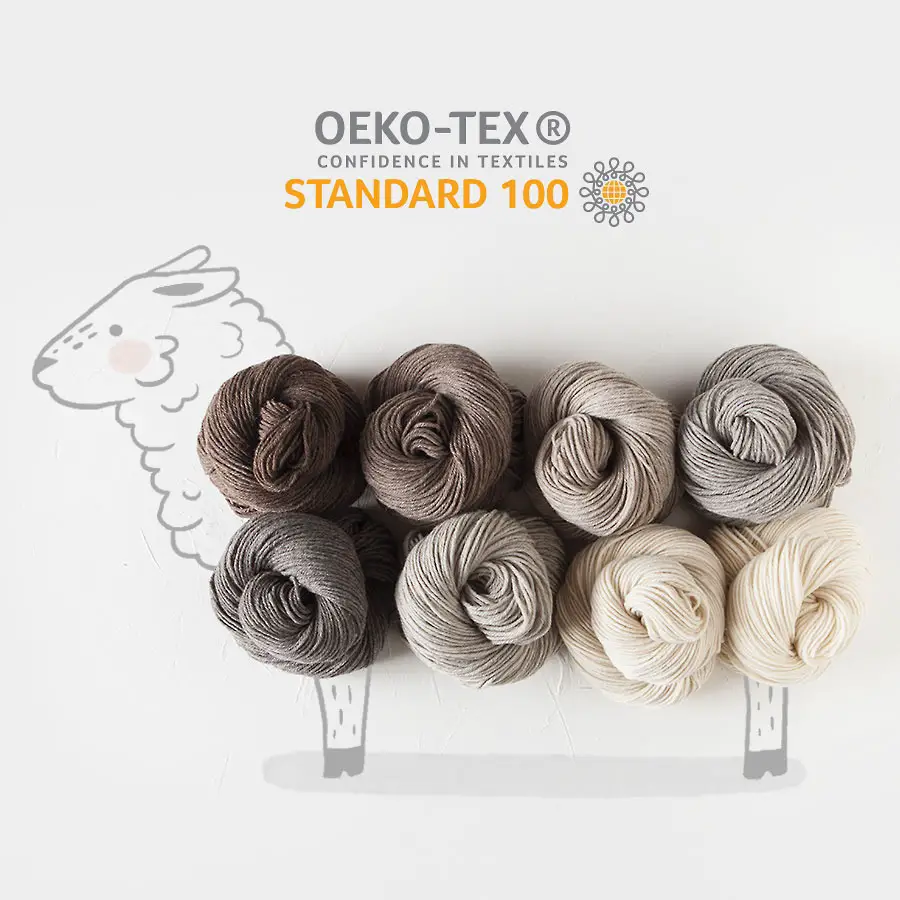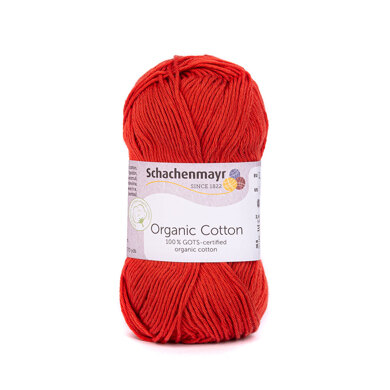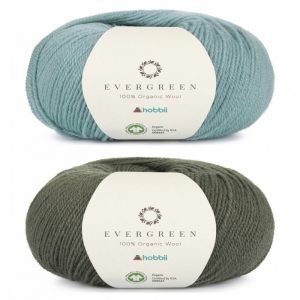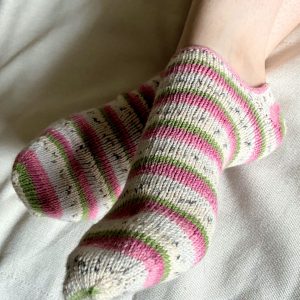Eco-friendly and sustainable yarn is a complex topic. For instance one would intuitively think that synthetic materials made of plastic aren’t eco-friendly but how about yarns made of recycled plastic bottles? Or is killing silk worms for their fibers eco-friendly?
There are no black and white answers what comes to this topic and the main goal of this article is to help you make more informed choices when shopping for yarn. I have also listed a few places where you can find sustainable options for your next knitting or crocheting project.
What Things Should you Consider When Selecting Eco-Friendly Yarn?
1. Animal Welfare
There are many factors that affect animal welfare. For instance, the main welfare issues affecting sheep are from mutilations, lameness, transport and illness caused by disease.
If you are looking for a completely vegan option choose plant-based yarn such as organic cotton, Tencel® or hemp.
2. Social Welfare
The working conditions and wages of the people involved in making the yarn is an important aspect of sustainable yarn.
3. Water Consumption
Water is needed for growing the raw materials, during the manufacturing process, and also for dying the yarn. Some methods use much less water than others.
This is an important factor to consider because in some areas there are people that don’t have access to drinking water while at the same time there’s a lot of water used for farming cotton for instance.
4. Use of Chemicals
There are different phases of the manufacturing process where chemicals can be used. For example, during growing to make the plants pest-resistant, during spinning to give the yarn certain properties, or after spinning as part of the dyeing process.
The use of chemicals is often necessary but it’s important to consider how eco-friendly the methods are.
5. Carbon blueprint
Carbon blueprint means the total amount of greenhouse gases emitted during the life of a product. The manufacturing, growing, raising, harvesting, and shipping all play a role in this number. For example, natural fibers such as wool and cotton have usually a lower carbon blueprint than synthetic fibers. But even within the same fiber type, there can be significant differences. For instance, if the yarn is processed far away from the place where the raw material is grown and sold shipping it back and forth will have a significant impact on the carbon footprint.
6. Overgrazing
Overgrazing is when animals graze on plants to the point where the plants can’t regenerate. This often happens with sheep in areas where there’s not enough land for them. When this happens, the soil gets eroded which causes problems such as floods and landslides.
7. Durability
The durability of yarn is important because it will affect how long the garment made from it will last. If a garment lasts longer, it means you don’t have to buy a new one as often which is good for the environment.
8. Recycling
Yarns made of natural fibers can mostly be recycled. For instance, wool can be composted but recycling synthetic yarns are usually a much more complex process.
Certifications
To make it a little bit easier for consumers to make informed decisions there are certifications provided by a third party that can be used to identify eco-friendly yarn. Below I have listed the most common ones.
Oeko-Tex
The Oeko-Tex 100 Standard is a certification that the labeled yarns have undergone laboratory testing for a wide range of harmful substances and that the content of those substances remains below the limit values established by the Oeko-Tex Association.
GOTS
The Global Organic Textile Standard (GOTS) is the worldwide leading textile processing standard for organic fibres, including ecological and social criteria, backed up by independent certification of the entire textile supply chain.
RWS
The Responsible Wool Standard (RWS) is a certification that ensures that wool is produced in an eco-friendly way. It takes into account animal and social welfare as well as the preservation of land health.
Eco-friendly Fibers
Wool
Wool as such is a natural fiber that can be composted so it could be considered an environment-friendly option but there are a few things you need to consider first.
Mulesing
Mulesing is the removal of strips of wool-bearing skin from around the breech of a sheep to prevent the parasitic infection flystrike. This operation is painful for the sheep and there are also other methods to prevent parasitizing; they are more costly to the breeder. You can read more about the method and alternatives to it here.
This method is used mostly in Australia for the merino sheep. If you buy merino wool and want to be sure that the sheep are not hurt check that the label says mulesing-free.
Superwash treatment
Untreated wool yarn is not an easy fabric to care for since it can shrink and felt easily. To solve this problem manufacturers use a superwash treatment that makes the yarn machine washable and resistant to felting.
The industry standard for a superwash treatment is called the chlorine-Hercosett process and this treatment uses hazardous chemicals. In developed countries, there are strict regulations that minimize the environmental impact of this treatment but in some countries, the chemicals might be even dumped into water.
You can tell if wool is superwash by looking at the label. If it says the machine was then this is the case.
Overgrazing
Overgrazing is a serious environmental issue. When animals graze an area too much the grasses can’t regenerate and the soil gets eroded. This destroys the habitats of many animals and plants.
Look for wool producers that have the Responsible Wool Standard (RWS). It ensures that farms use best practices to protect the land, and treat the animal decently.
Eco-friendly Wool Yarns
Hobbii Evergreen Organic Wool and Juniper Moon Farm Patagonia are organic wool yarns (GOTS certified). All KnitPicks wool comes from RWS certified producers.
Cotton
Cotton is a natural fiber but the way it’s grown and processed can have a big impact on the environment.
- For instance, conventional cotton uses a lot of pesticides and water and in the meantime, people in the same region don’t necessarily have access to drinking water.
- In developing countries, where cotton is grown, the working conditions and wages might not meet our standards.
- The use of fertilizers and genetically modified seeds is widespread in conventional cotton farming. Fertilizers can seep into groundwater and damage ecosystems, while GM seeds can lead to the development of herbicide-resistant weeds.
Organic Cotton
If you want to be sure that the cotton yarn you buy is eco-friendly select organic yarn and look for the GOTS certification. If the yarn has this certification it means that it is manufactured in both environmentally friendly and socially sustainable ways.
Eco-Friendly Cotton Yarns
Below are a few organic cotton yarns (GOTS certified) that you can buy online.
Recycled Cotton
Another eco-friendly option is recycled cotton which is made from fabric waste that would otherwise end up in a landfill. This process uses less water and energy than growing new cotton.
The quality of the yarn might not be as good as virgin cotton but it’s a good eco-friendly option. If you are interested in recycled cotton yarn check out for instance the Cotton T-Shirt Yarn by Darn Good Yarn or the Denim Breeze by Hobbii.
Hemp
Hemp is a strong and eco-friendly fiber that is harvested from the Cannabis Sativa plant, the same one that produces marijuana and its derivatives. It feels similar to cotton but is lighter and a little bit rougher.
Hemp is grown without the use of pesticides and the processing doesn’t require any harsh chemicals. In addition, it’s completely biodegradable and can be composted.
For instance Darn Good Yarn online store has several hemp yarns on their shelves.
Linen
Linen is an eco-friendly fiber that is made from the flax plant. Growing the flax requires only a small amount of water and little or no pesticides. In addition, it retains CO2 in the atmosphere.
Linen is a strong and durable fiber but it can feel rough when new. With time, it becomes softer and more pleasant to wear.
Lino 100% from Katia is a lace weight yar made from pure linen.
Lyocell (Tencel®)
Lyocell is a soft, absorbent, and light fiber that is made from wood pulp usually from eucalyptus, beech, birch, and spruce trees. The chemicals used in the production process are recycled with minimal waste and very low emissions. The production of lyocell uses less water than the production of cotton but it’s important to look into whether the lyocell in your garment comes from sustainably sourced raw materials.
Tencel® was awarded “European Award for the Environment” by the European Union and it has also the EU ecolabel that is awarded to products and services which have a significantly lower environmental impact throughout their entire lifecycle.
Wool and the Gang has several Tencel yarns available on their site.
Avoid These Yarns
Most synthetic fibers such as acrylic, polyester, and nylon are made from fossil fuels. The production of these fibers releases greenhouse gases and harmful chemicals into the environment. However, I think that nylon has its place for instance reinforcing sock yarns and it makes the end product last much longer.
These yarns are often cheaper than natural fibers but they come at a high cost to the environment. If you want to knit eco-friendly projects avoid these yarns.
FAQ
There are no black and white answers what comes to this topic. The things you need to consider are animal and social welfare, water consumption, use of chemicals, carpon blueprint, overgrazing, the durability of the material and how can it be recycled. Hemp and linen are typically good options and so are organic wool and organic cotton.
Acrylic yarn is not eco friendly because it’s made from oil that is a fossil fuel and the manufacturing process has a significant carbon footprint. In addition every time the yarn is washed, it releases tiny fibers called microplastics into the water supply. Also since it’s plastic it is hard to recycle.
It depends. The way cotton is grown can have a negative impact on nature because it uses a lot of pesticides and water. Also in developing countries, where cotton is grown, the working conditions and wages might not meet our standards.
If you want to buy cotton yarn that is manufactured in both environmentally friendly and socially sustainable ways choose products that have GOTS certification such as Hobbii Baby Cotton Organic.
It depends. Bamboo grows fast and requires no fertiliser and it can be grown sustainably. However, there are two ways to manufacture the yarn and the one that is the most popular uses a lot of checimals and is not environmentally friendly.
Tencel that has many of the same qualities as bamboo is a more environmentally friendly option.


















2 Responses
Thank you for all this information! It can be so difficult to track down yarn that feels good to the heart as well as the touch.
I know you said to stay away from synthetics but Lionsbrand has a new yarn out called Re-Spun that is made from 100% post consumer waste. I’m making some items now to test how well this yarn holds up but honestly, what a great thing to keep plastics out of our landfills and oceans! I love it that some of the commercial brand names in yarn are thinking of these things.